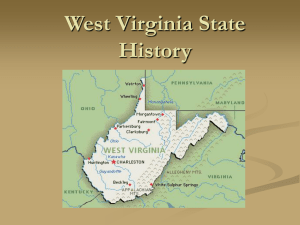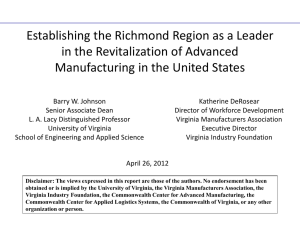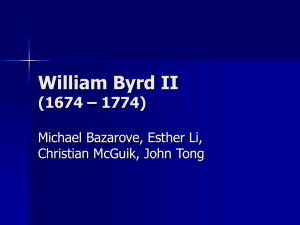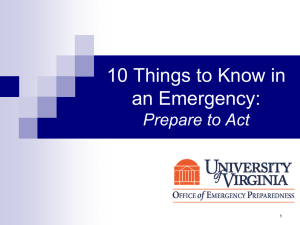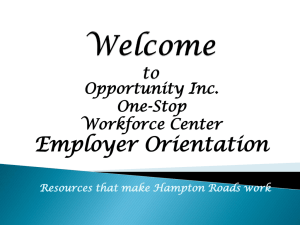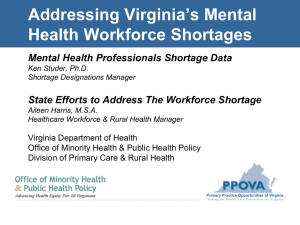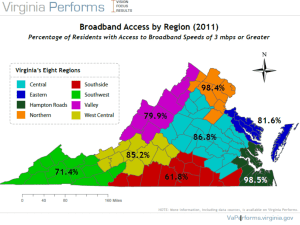WV-College-Transition
advertisement
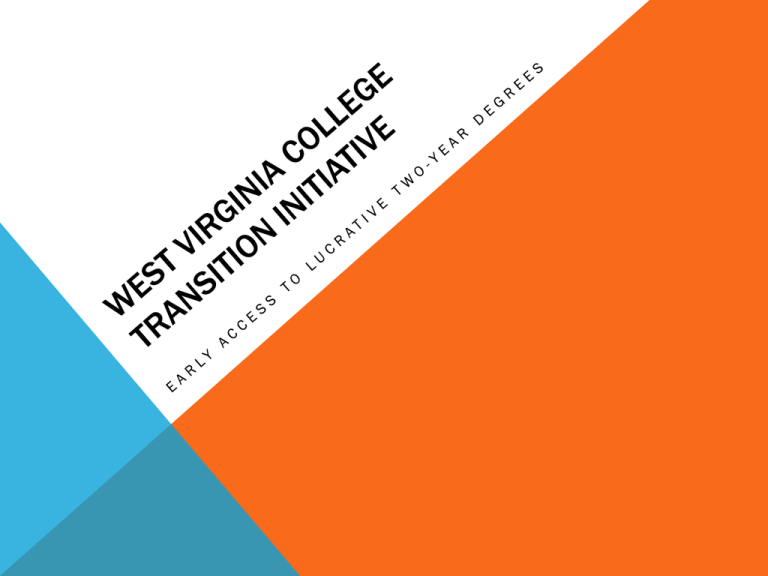
TODAY’S PRESENTATION TEAM Linda Sutton – WV Community and Technical College Coordinator for College Transition Initiative Linda Cronin – North Central WV College Transition Coordinator Melissa Jones - Calhoun County High School - College Transition Instructor West Virginia Legislature provided funds to implement a statewide initiative for the “middle” group of students and first generation college-going students access to a college course while in high school or a career and technical center The funds initially allowed the 10 Community and Technical Colleges in West Virginia to market and implement two (2) cohorts of 20 students, a college level introductory course The Claude Benedum Foundation supported our initiative with additional funding to expand delivery to more students statewide ONE STATEWIDE INITIATIVE 10 COMMUNITY AND TECHNICAL COLLEGES 28 CAMPUSES If West Virginia is going to have enough skilled workers to meet the needs of the economy, half of the state’s workforce will need education and training beyond high school by 2018. West Virginia’s workforce is facing a skills gap • 20,000 additional certificate or degree completers are needed by 2018. • Labor economists predict that by 2018, 49% of the jobs in West Virginia will require education and training beyond high school.¹ • Much of the skills gap is going to be concentrated in “middle skill” jobs; those that require more than a high school diploma but less than a four-year degree. • Types of jobs needed: advanced manufacturing, construction, energy, bio- and nanotechnology, cyber security, information technology, telecommunications and public safety. 54% of the needed jobs fall into this category.² • Without an educated workforce, West Virginia will simply not be able to sustain its economy. Without increasing college completion rates, West Virginia will not have the educated workforce it needs. 1. Carnevale, A. P., Smith, N., & Strohl, J. (2010). Help Wanted: Projections of Jobs and Education Requirements Through 2018. Washington, DC: Georgetown Center on Education and the Workforce. 2. Unruh, R. (2011). Driving Innovation from the Middle. Washington, DC: National Skills Coalition. Efforts to reach this completion goal must be guided by four fundament principles. 1. Higher education institutions must partner with secondary schools and employers to help align learning objectives and stop the leaks in the education pipeline. 2. Second, clear and effective communication within institutions and across public and private partners is essential to ensuring that all parties have access to the information they need to achieve this goal. 3. Quality must remain central to all of these efforts and cannot be sacrificed to increase completion. 4. Access to higher education must be an opportunity for all citizens. Emphasizing partnership and communication, while protecting quality and access should be part of any completion effort • • • • Partner with High Schools and Career Center to expose and prepare students for career pathways tied to regional economic needs and to the Community and Technical College programs of study Offer the College Transition course to as many students as possible to ensure they have exposure to how Community Colleges can prepare for entry into the workforce using Standardized student selection criteria, textbooks, and learning objectives, but with Flexible delivery methods Original Design: Student Selection: with assistance from school’s High School Counselor and Administration Parent Involvement – Orientation program and signature of Memorandum of Understanding 3 hour College Credit Bearing Course Offered to Sophomores Follow Up Opportunities for College Credit Junior & Senior Year Current Design: Redesign of 3 hour course to 1 hour course Focus on Seniors Primary Target population: Career and Technical Center students Include FASA education, College Program of Studies, Resume and Interview education, Admission form completion and College site visit PIERPONT COMMUNITY AND TECHNICAL COLLEGE Common questions addressed during planning phase: Who –Student selection process Where – CTC campus or the career center How - Adjunct instructor – traveling/dual What – course alignment / curriculum committee Offered as Dual credit with secondary instructors serving as adjuncts Credit bearing course HUSV 1100 Blackboard MyMathTest.com Campus visit Location & Area – Access to Colleges 10th Grade Intro to the Majors – Dual Credit Math & English Remediation Galaxy Tablets & iPads Pilot Electronic textbooks COLLEGE 101 – THE CLASS College and Career Research Projects Setting Goals Time Management Classroom Etiquette Learning Styles Improving Memory Note Taking Thinking Critically Test Taking Strategies A Few Words From Former College 101 Students “I honestly couldn’t pick one thing that helped me the most from the course, because everything we went over in the book was very useful and gave me a great toolset to help me in literally any aspect of life. I still have my book, and refer to it quite frequently.” - - Josh Adams, WV Wesleyan College “Time management was probably the most important thing that I learned from it. It not only helps you with managing your school work, but it also helps you manage ‘real’ life. I can honestly say that if I had not taken this class, I would not have been prepared for college at all.” - - Andrew Wilson, Calhoun Banks “I think the structure of the class prepares students of what to expect a college class and atmosphere to be like. Learning how to take ‘good’ notes was extremely useful for preparing for college. Basically, this class teaches you how to be successful and responsible student or individual.” - - Brandi Bain, WVU “Two words…Time Management!” – Quentin Murphy, Glenville State College “The class was excellent at preparing me for college. I had to take another university orientation class at my current institution and it paled in comparison to the College 101 course that was offered at Calhoun High School. The class at Calhoun answered the questions and concerns we had as prospective college students and prepared us for our college career. We were taught how to manage time, study for exams , speak to our professors, and understand our role as students.” – Leslie Garrett, University of Charleston “If you give a student a blue crayon he/she might be able to create a decent piece of art. But you won’t know the full potential of the student unless you give them a whole box of crayons. In essential, the College 101 course to me was like a box of crayons. The course opened doors, improved study habits, worked on time management skills, and overall excelled my college career. Without that box of crayons I would be stuck with a single crayon, I might have knowledge, but I wouldn’t be able to tackle college.” - - Zach Hanshaw, Davis & Elkins College WV College Transition(CT) Students 700 600 500 400 300 200 100 0 608 395 400 435 478 320 CT Students ….that tells the story of many of our West Virginia students: From one of our instructors, Fall 2012: “This afternoon I met with a student I had this fall term for only a month and half. She had very poor attendance and thought dropping out was her only option since she is the only one at home working and had little support to attend school. I worked with her to convince her not to drop out of school. The results: Instead of dropping out, she graduated early in December, attended orientation at our Community and Technical College, and will be a full time pre-nursing student with us in Fall 2013. She even tested into college level Math and English! She is a first generation college student as well as a first generation high school graduate. Also, our financial aid counselors were great to take time to help her understand the grants she had been awarded and gave her another positive contact/experience at our Community College. Great way to end the day!” September 18, 2013: United States Senator Jay Rockefeller for West Virginia announced $25 million in federal funding for the Bridging the Gap Consortium, a group of 10 community and technical colleges in West Virginia dedicated to expanding and improving education and career training programs in fields that lead to high-wage, highskilled jobs and careers.* Projection for 2013 – 2014 School Year: 812 students to participate -one career and technical school is offering the 1 hour course to Junior & Seniors in technical programs – 400 students *Funding allocated under the Department of Labor’s Trade Adjustment Assistance (TAA) Community College and Career Training funding program QUESTIONS


